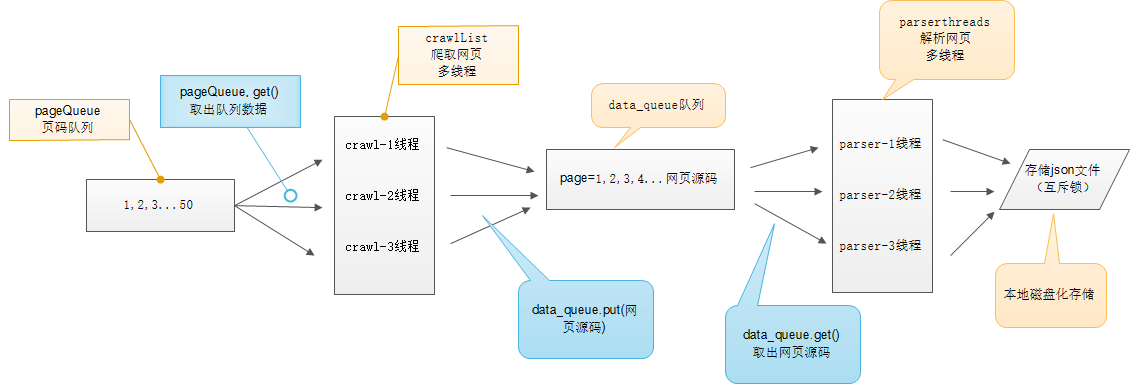多线程糗事百科案例
案例要求参考上一个糗事百科单进程案例
Queue(队列对象)
Queue是python中的标准库,可以直接import Queue引用;队列是线程间最常用的交换数据的形式
python下多线程的思考
对于资源,加锁是个重要的环节。因为python原生的list,dict等,都是not thread safe的。而Queue,是线程安全的,因此在满足使用条件下,建议使用队列
-
初始化: class Queue.Queue(maxsize) FIFO 先进先出
-
包中的常用方法:
-
Queue.qsize() 返回队列的大小
-
Queue.empty() 如果队列为空,返回True,反之False
-
Queue.full() 如果队列满了,返回True,反之False
-
Queue.full 与 maxsize 大小对应
-
Queue.get([block[, timeout]])获取队列,timeout等待时间
-
-
创建一个“队列”对象
- import Queue
- myqueue = Queue.Queue(maxsize = 10)
-
将一个值放入队列中
- myqueue.put(10)
-
将一个值从队列中取出
- myqueue.get()
多线程示意图
import threading
from queue import Queue
from lxml import etree
import requests
import json
import time
class ThreadCrawl(threading.Thread):
def __init__(self, threadName, pageQueue, dataQueue):
# 调用父类的初始化方法
# threading.Thread.__init__(self)
super(ThreadCrawl, self).__init__()
# 线程的名字
self.threadName = threadName
# 页码队列
self.pageQueue = pageQueue
# 数据队列
self.dataQueue = dataQueue
# 请求报头
self.headers = {
"Uaer-Agent": "Mozilla/5.0 (Macintosh; U; Intel Mac OS X 10_6_8; en-us) AppleWebKit/534.50 (KHTML, like Gecko) Version/5.1 Safari/534.50"
}
def run(self):
print('启动:{}'.format(self.threadName))
while not CRAWL_EXIT:
try:
# 取出队列中的一个数字, 先进先出
# 可选参数block, 默认值为True, 两种用法
# 1. 如果队列为空, block为True的话, 不会结束, 就会进入阻塞状态, 知道队列有新的数据
# 2. 如果队列为空, block为False的话, 就会弹出一个Queue.empty()异常
page = self.pageQueue.get(False)
url = 'http://www.qiushibaike.com/8hr/page/{}/'.format(page)
content = requests.get(url, headers=self.headers).text
# content = content.decode('utf-8')
# print(content)
time.sleep(1)
self.dataQueue.put(content)
except:
pass
print('结束:{}'.format(self.threadName))
class ThreadParse(threading.Thread):
def __init__(self, threadName, dataQueue, filename, lock):
super(ThreadParse, self).__init__()
# 线程的名字
self.threadName = threadName
# 数据队列
self.dataQueue = dataQueue
# 保存解析后数据的文件名
self.filename = filename
# 锁
self.lock = lock
def run(self):
print('启动:{}'.format(self.threadName))
while not PARSE_EXIT:
try:
html = self.dataQueue.get(False)
self.parse(html)
except:
pass
print('结束:{}'.format(self.threadName))
def parse(self, html):
# 解析为HTML DOM
html = etree.HTML(html)
node_list = html.xpath('//div[contains(@class, "article block untagged mb15")]')
for node in node_list:
# print(node)
# xpath返回的列表,这个列表就这一个参数,用索引方式取出来,用户名
# .//h2 用户名
username = node.xpath('.//h2')[0].text.strip()
# print('username==={}'.format(username))
# .//div[@class="thumb"]//@src 图片连接
image = node.xpath('.//div[@class="thumb"]//@src')
# print('image==={}'.format(image))
# .//div[@class="content"]/span 取出标签下的内容,段子内容
content = node.xpath('.//div[@class="content"]/span')[0].text.strip()
# print('content==={}'.format(content))
# .//i[@class="number"][0] 点赞 取出标签里包含的内容,点赞
zan = node.xpath('.//i[@class="number"]')[0].text
# print('zan==={}'.format(zan))
# .//i[@class="number"][i] 评论
comments = node.xpath('.//i[@class="number"]')[1].text
# print('comments==={}'.format(comments))
items = {
"username" : username,
"image" : image,
"content" : content,
"zan" : zan,
"comments" : comments
}
# with 后面有两个必须执行的操作:__enter__ 和 _exit__
# 不管里面的操作结果如何,都会执行打开、关闭
# 打开锁、处理内容、释放锁
# print("正在写入内容!!!")
with self.lock:
# print("正在写入内容!!!")
# # 写入存储的解析后的数据
# json_data = json.dumps(items, ensure_ascii=False)
# print('jsondata==={}'.format(json_data))
# self.filename.write(json_data.encode("utf-8") + "\n")
self.filename.write(str(json.dumps(items, ensure_ascii = False))+'\n')
print("写入完成!!!")
# 采集爬虫退出信号
CRAWL_EXIT = False
# 解析爬虫退出信号
PARSE_EXIT = False
def main():
# 页码的队列, 表示10个页面
pageQueue = Queue(10)
# 放入1~10个数字, 先进先出
for i in range(1, 11):
pageQueue.put(i)
# 采集结果(每页的html源码)的数据队列, 参数为空表示不限制
dataQueue = Queue()
filename = open('duanzi.json', 'a', encoding='utf-8')
print("打开文件!!!")
# 创建锁
lock = threading.Lock()
# 三个采集线程的名字
crawlList = ["采集线程1号", "采集线程2号", "采集线程3号"]
# 存储三个采集线程的列表集合
threadcrawl = []
for threadName in crawlList:
thread = ThreadCrawl(threadName, pageQueue, dataQueue)
thread.start()
threadcrawl.append(thread)
time.sleep(1)
# 三个解析线程的名字
parseList = ["解析线程1号", "解析线程2号", "解析线程3号"]
# 存储三个解析线程
threadparse = []
for threadName in parseList:
thread = ThreadParse(threadName, dataQueue, filename, lock)
thread.start()
threadparse.append(thread)
# 等待pageQueue队列为空, 等待之前的操作执行完毕
while not pageQueue.empty():
pass
# 如果pageQueue为空, 采集线程退出循环
global CRAWL_EXIT
CRAWL_EXIT = True
print('pageQueue队列为空')
for thread in threadcrawl:
thread.join()
print("1")
while not dataQueue.empty():
pass
global PARSE_EXIT
PARSE_EXIT = True
for thread in threadparse:
thread.join()
print("2")
with lock:
print("关闭文件!!!")
# 关闭文件
filename.close()
print("谢谢使用")
if __name__ == '__main__':
main()
